Yuchen Su
Explicit Relational Reasoning Network for Scene Text Detection
Dec 19, 2024
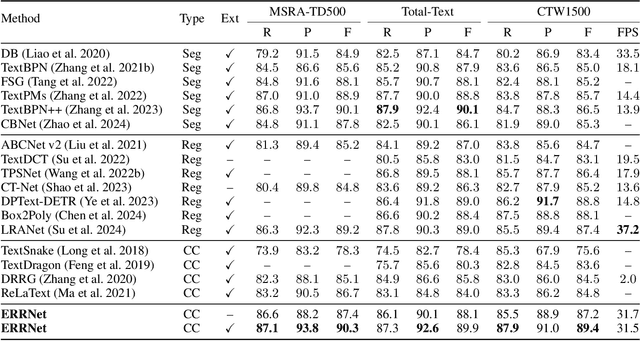
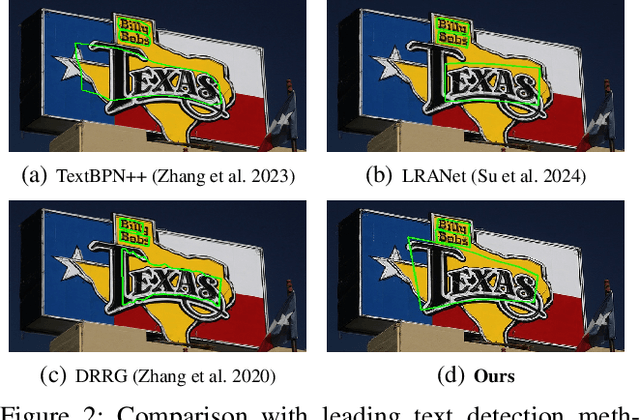
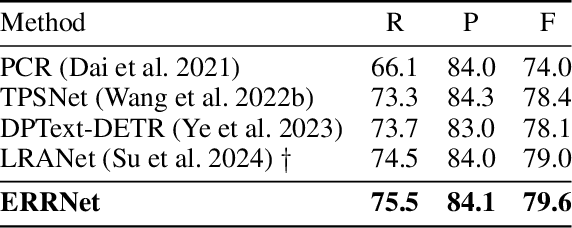
Abstract:Connected component (CC) is a proper text shape representation that aligns with human reading intuition. However, CC-based text detection methods have recently faced a developmental bottleneck that their time-consuming post-processing is difficult to eliminate. To address this issue, we introduce an explicit relational reasoning network (ERRNet) to elegantly model the component relationships without post-processing. Concretely, we first represent each text instance as multiple ordered text components, and then treat these components as objects in sequential movement. In this way, scene text detection can be innovatively viewed as a tracking problem. From this perspective, we design an end-to-end tracking decoder to achieve a CC-based method dispensing with post-processing entirely. Additionally, we observe that there is an inconsistency between classification confidence and localization quality, so we propose a Polygon Monte-Carlo method to quickly and accurately evaluate the localization quality. Based on this, we introduce a position-supervised classification loss to guide the task-aligned learning of ERRNet. Experiments on challenging benchmarks demonstrate the effectiveness of our ERRNet. It consistently achieves state-of-the-art accuracy while holding highly competitive inference speed.
Hint-AD: Holistically Aligned Interpretability in End-to-End Autonomous Driving
Sep 10, 2024
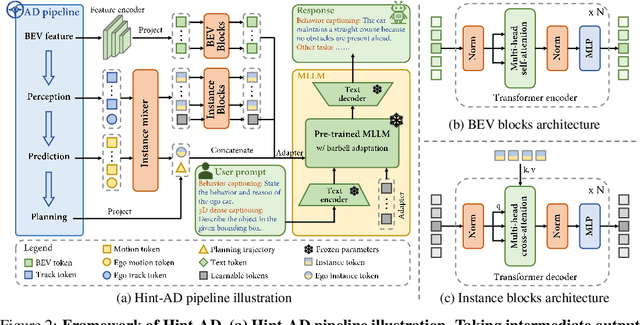

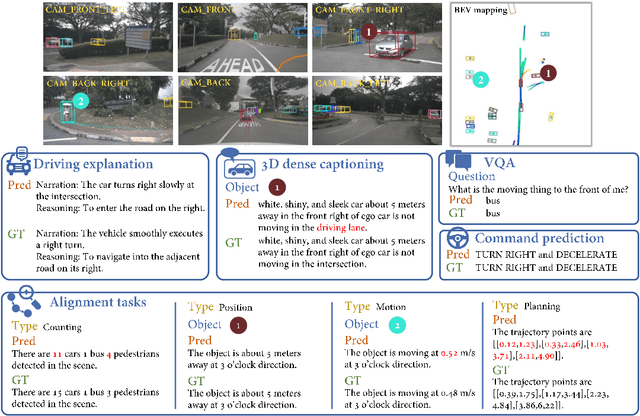
Abstract:End-to-end architectures in autonomous driving (AD) face a significant challenge in interpretability, impeding human-AI trust. Human-friendly natural language has been explored for tasks such as driving explanation and 3D captioning. However, previous works primarily focused on the paradigm of declarative interpretability, where the natural language interpretations are not grounded in the intermediate outputs of AD systems, making the interpretations only declarative. In contrast, aligned interpretability establishes a connection between language and the intermediate outputs of AD systems. Here we introduce Hint-AD, an integrated AD-language system that generates language aligned with the holistic perception-prediction-planning outputs of the AD model. By incorporating the intermediate outputs and a holistic token mixer sub-network for effective feature adaptation, Hint-AD achieves desirable accuracy, achieving state-of-the-art results in driving language tasks including driving explanation, 3D dense captioning, and command prediction. To facilitate further study on driving explanation task on nuScenes, we also introduce a human-labeled dataset, Nu-X. Codes, dataset, and models will be publicly available.
Instruction-Guided Scene Text Recognition
Jan 31, 2024


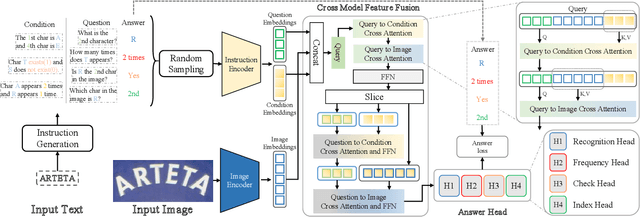
Abstract:Multi-modal models have shown appealing performance in visual tasks recently, as instruction-guided training has evoked the ability to understand fine-grained visual content. However, current methods cannot be trivially applied to scene text recognition (STR) due to the gap between natural and text images. In this paper, we introduce a novel paradigm that formulates STR as an instruction learning problem, and propose instruction-guided scene text recognition (IGTR) to achieve effective cross-modal learning. IGTR first generates rich and diverse instruction triplets of <condition,question,answer>, serving as guidance for nuanced text image understanding. Then, we devise an architecture with dedicated cross-modal feature fusion module, and multi-task answer head to effectively fuse the required instruction and image features for answering questions. Built upon these designs, IGTR facilitates accurate text recognition by comprehending character attributes. Experiments on English and Chinese benchmarks show that IGTR outperforms existing models by significant margins. Furthermore, by adjusting the instructions, IGTR enables various recognition schemes. These include zero-shot prediction, where the model is trained based on instructions not explicitly targeting character recognition, and the recognition of rarely appearing and morphologically similar characters, which were previous challenges for existing models.
CT-Net: Arbitrary-Shaped Text Detection via Contour Transformer
Jul 25, 2023



Abstract:Contour based scene text detection methods have rapidly developed recently, but still suffer from inaccurate frontend contour initialization, multi-stage error accumulation, or deficient local information aggregation. To tackle these limitations, we propose a novel arbitrary-shaped scene text detection framework named CT-Net by progressive contour regression with contour transformers. Specifically, we first employ a contour initialization module that generates coarse text contours without any post-processing. Then, we adopt contour refinement modules to adaptively refine text contours in an iterative manner, which are beneficial for context information capturing and progressive global contour deformation. Besides, we propose an adaptive training strategy to enable the contour transformers to learn more potential deformation paths, and introduce a re-score mechanism that can effectively suppress false positives. Extensive experiments are conducted on four challenging datasets, which demonstrate the accuracy and efficiency of our CT-Net over state-of-the-art methods. Particularly, CT-Net achieves F-measure of 86.1 at 11.2 frames per second (FPS) and F-measure of 87.8 at 10.1 FPS for CTW1500 and Total-Text datasets, respectively.
Efficient and Accurate Scene Text Detection with Low-Rank Approximation Network
Jun 27, 2023Abstract:Recently, regression-based methods, which predict parameter curves for localizing texts, are popular in scene text detection. However, these methods struggle to balance concise structure and fast post-processing, and the existing parameter curves are still not ideal for modeling arbitrary-shaped texts, leading to a challenge in balancing speed and accuracy. To tackle these challenges, we firstly propose a dual matching scheme for positive samples, which accelerates inference speed through sparse matching scheme and accelerates model convergence through dense matching scheme. Then, we propose a novel text contour representation method based on low-rank approximation by exploiting the shape correlation between different text contours, which is complete, compact, simplicity and robustness. Based on these designs, we implement an efficient and accurate arbitrary-shaped text detector, named LRANet. Extensive experiments are conducted on three challenging datasets, which demonstrate the accuracy and efficiency of our LRANet over state-of-the-art methods. The code will be released soon.
TextDCT: Arbitrary-Shaped Text Detection via Discrete Cosine Transform Mask
Jun 27, 2022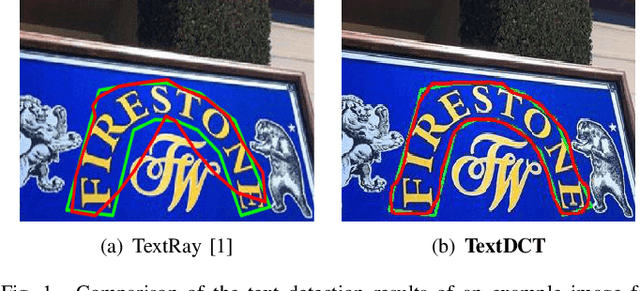
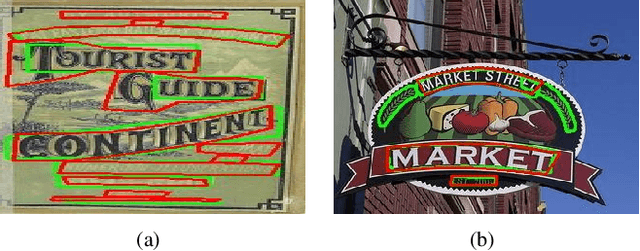
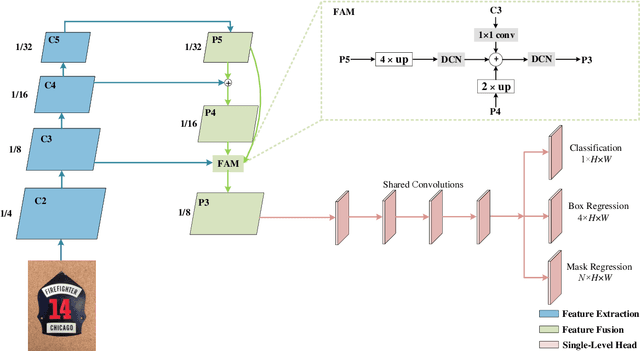
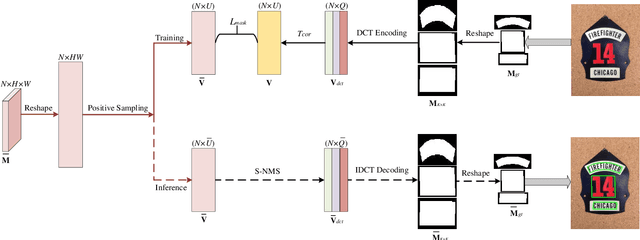
Abstract:Arbitrary-shaped scene text detection is a challenging task due to the variety of text changes in font, size, color, and orientation. Most existing regression based methods resort to regress the masks or contour points of text regions to model the text instances. However, regressing the complete masks requires high training complexity, and contour points are not sufficient to capture the details of highly curved texts. To tackle the above limitations, we propose a novel light-weight anchor-free text detection framework called TextDCT, which adopts the discrete cosine transform (DCT) to encode the text masks as compact vectors. Further, considering the imbalanced number of training samples among pyramid layers, we only employ a single-level head for top-down prediction. To model the multi-scale texts in a single-level head, we introduce a novel positive sampling strategy by treating the shrunk text region as positive samples, and design a feature awareness module (FAM) for spatial-awareness and scale-awareness by fusing rich contextual information and focusing on more significant features. Moreover, we propose a segmented non-maximum suppression (S-NMS) method that can filter low-quality mask regressions. Extensive experiments are conducted on four challenging datasets, which demonstrate our TextDCT obtains competitive performance on both accuracy and efficiency. Specifically, TextDCT achieves F-measure of 85.1 at 17.2 frames per second (FPS) and F-measure of 84.9 at 15.1 FPS for CTW1500 and Total-Text datasets, respectively.
 Add to Chrome
Add to Chrome Add to Firefox
Add to Firefox Add to Edge
Add to Edge